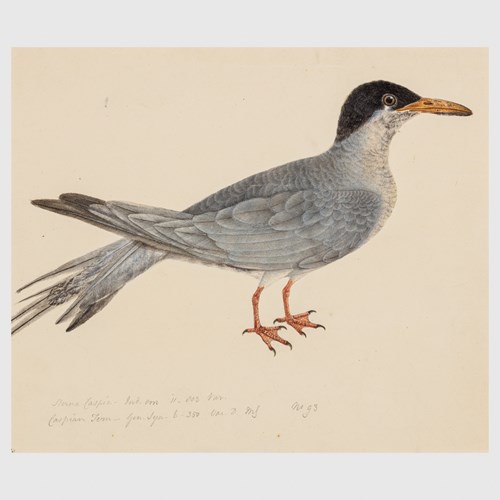Marketplace
Early Victorian Silver Gilt Dagger and Scabbard
Modelled after an Ottoman bichaq, this intricately patterned dagger and scabbard was made by the silversmith Joseph Willmore of Birmingham in 1843/1844. Five small hallmarks are found below the locket. From left to right, they are a woman’s head in profile, a lion statant guardant, the initials JW, an anchor, and the letter ‘U’ in gothic typeset. These indicate, respectively, that this item was made during the reign of Queen Victoria, of Sterling Silver .925, by Joseph Willmore, in Birmingham, and was assayed in the years 1843-1844.
Willmore (1773-1885) began his career as a buckle maker but had registered as a maker of silver gilt cutlery in Birmingham in the 1830s.1 The swirling baroque foliate decoration for which the handles of his cutlery were prized is replicated in this dagger. This is the only weapon that Willmore is known to have made. Furthermore, though a handful of nineteenth-century French replicas of yatagan-style daggers exists, this is the only known British example. In the centre of the scabbard, on both sides, there is a bird with its wings outspread. The positioning of the bird, with its wings displayed abaissé, suggests that it is heraldic insignia. Thus, the dagger may have been a special commission for an individual from a British noble family, perhaps as a souvenir from his Grand Tour.
The silver gilt wooden scabbard protects a single-edged flat steel blade, which is etched with floral motifs. The locket is decorated with three horizontal bands of detail. A small loop attachment below the locket allows the dagger to be hung from the waistband, as it was traditionally worn by Ottoman soldiers. The scabbard terminates in a delicate openwork finial formed by two scrolls. The rococo ornamentation indicates that the source material is a Balkan bichaq. Neoclassical motifs such as laurel wreaths, an amphora, and a cornucopia, are nestled between the baroque foliation of the scabbard.
Meaning literally ‘knife’, the term bichaq is used to refer to daggers shaped like yatagans, light Ottoman swords. Their distinctive form evolved through practical use. The v-shaped pommel prevented the hilt from slipping in the hand during use, and their lightly recurved shape, similar to that of a machete, elongates the blade and thereby increases the pressure on the sharp edge. They were particularly useful for slashing at neck plates, a weak point in western suits of armour. Decorative bichaq were also worn by men as a status symbol, with highly ornamented examples found in the Metropolitan Museum of Art, New York (accession no. 36.25.685a, b) and the Victoria & Albert Museum, London (accession no. 1573 to B-1888).2
n.b. accession nos are clickable links
1 ‘Birmingham Silversmiths: The Willmores and the Linwoods’, History West Midlands, retrieved from https://www.revolutionaryplayers.org.uk/birmingham-silversmiths-the-willmores-and-linwoods/ on 28/09/23.
2 Atıl, Esin. The Age of Süleyman the Magnificent. Washington, D.C.: National Gallery of Art, 1987. p. 147.
Willmore (1773-1885) began his career as a buckle maker but had registered as a maker of silver gilt cutlery in Birmingham in the 1830s.1 The swirling baroque foliate decoration for which the handles of his cutlery were prized is replicated in this dagger. This is the only weapon that Willmore is known to have made. Furthermore, though a handful of nineteenth-century French replicas of yatagan-style daggers exists, this is the only known British example. In the centre of the scabbard, on both sides, there is a bird with its wings outspread. The positioning of the bird, with its wings displayed abaissé, suggests that it is heraldic insignia. Thus, the dagger may have been a special commission for an individual from a British noble family, perhaps as a souvenir from his Grand Tour.
The silver gilt wooden scabbard protects a single-edged flat steel blade, which is etched with floral motifs. The locket is decorated with three horizontal bands of detail. A small loop attachment below the locket allows the dagger to be hung from the waistband, as it was traditionally worn by Ottoman soldiers. The scabbard terminates in a delicate openwork finial formed by two scrolls. The rococo ornamentation indicates that the source material is a Balkan bichaq. Neoclassical motifs such as laurel wreaths, an amphora, and a cornucopia, are nestled between the baroque foliation of the scabbard.
Meaning literally ‘knife’, the term bichaq is used to refer to daggers shaped like yatagans, light Ottoman swords. Their distinctive form evolved through practical use. The v-shaped pommel prevented the hilt from slipping in the hand during use, and their lightly recurved shape, similar to that of a machete, elongates the blade and thereby increases the pressure on the sharp edge. They were particularly useful for slashing at neck plates, a weak point in western suits of armour. Decorative bichaq were also worn by men as a status symbol, with highly ornamented examples found in the Metropolitan Museum of Art, New York (accession no. 36.25.685a, b) and the Victoria & Albert Museum, London (accession no. 1573 to B-1888).2
n.b. accession nos are clickable links
1 ‘Birmingham Silversmiths: The Willmores and the Linwoods’, History West Midlands, retrieved from https://www.revolutionaryplayers.org.uk/birmingham-silversmiths-the-willmores-and-linwoods/ on 28/09/23.
2 Atıl, Esin. The Age of Süleyman the Magnificent. Washington, D.C.: National Gallery of Art, 1987. p. 147.
More artworks from the Gallery









